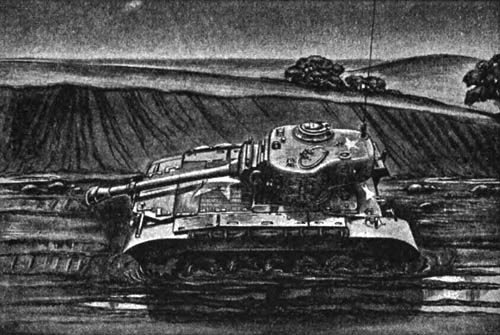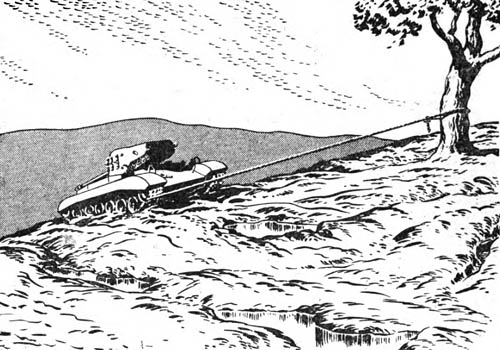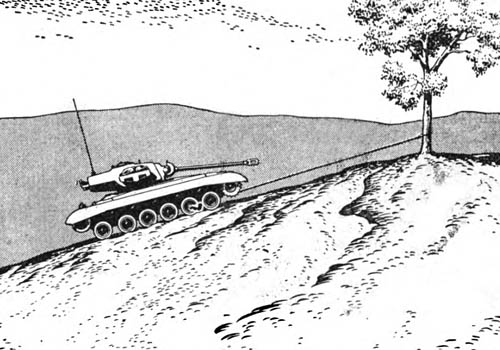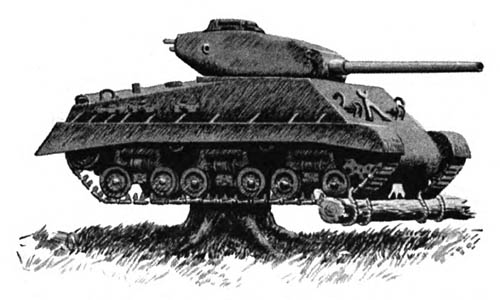Tank driver instructions for dealing with mud, thrown tracks, and bellied tanks from From TM 21-306: Manual for the Full Track Vehicle Driver, War Department, August 1946.
CHAPTER 6: FIELD EXPEDIENTS
32. GENERAL. Field expedients are based on a common sense use of the things you have in the field with which to do a job. A few minutes of thought before starting the work often save hours of unnecessary labor.
33. CONTROLLED DIFFERENTIAL. A number of field expedients for full-track vehicles are based on the way the controlled differential works. If your vehicle has thrown or broken one track, you can move the vehicle by holding back on the steering lever on the same side. This throws power over to the side that has the track and your vehicle moves either forward or in reverse. However, if you do not hold back on this steering lever, the vehicle stands still because the power is thrown to the sprocket which is free to turn without the track. Paragraphs 34 through 38 describe several of the most common field expedients.
34. ONE TRACK SPINNING. To move a full-track vehicle which has one track on solid ground and the other spinning in the mud, pull back on the steering lever on the same side as the spinning track. This throws power to the track on solid ground and your vehicle moves out. (See fig. 36.) To move the vehicle in a straight line pull back alternately on the levers.
Figure 36. When in mud and only one track spins, move the vehicle by holding back on the steering lever on the same side as the spinning track.
35. SLIPPERY HILL. a. To move a full-track vehicle up a slippery hill or incline (fig. 37)—
(1) Attach one end of the cable to a track.
(2) Attach the other end to a tree or dead man.
(3) Hold back on the steering lever on the side opposite to the anchored track and move the vehicle forward until the end of the cable passes the rear bogie wheel.
(4) Disconnect the cable and, if the vehicle still cannot gain traction, repeat the procedure.
b. If both tracks are slipping, two evenly spread cables are used. Do not pull back on either steering lever except to keep the cables centered on the tracks.
Figure 37. Move the vehicle up a slippery hill by anchoring one track with a cable and holding back on the opposite steering lever.
36. THROWN TRACKS. To move a full-track vehicle when one or both tracks are off, use one sprocket as a winch. (See fig. 38.)
a. Attach the cable to the sprocket on the side with the thrown track so that it will wind up when the sprocket turns.
b. Attach the other end of the cable to an anchor.
c. Hold back on the steering lever on the side opposite the cable and move the Vehicle forward.
Figure 38. When one or both tracks are thrown, move the vehicle by using the sprocket as a winch.
37. BELLIED VEHICLE. To remove a vehicle bellied on a stump or in mud, chain a log to the tracks. (See fig. 39.)
a. Cut a log that is at least 12 inches in diameter.
b. Lay the log in front of the tracks.
c. Attach each end of the log to a track.
d. By use of the engine, move the tracks to the rear so that the log will strike the stump, or, if the vehicle is bellied in mud, so that it will lift the vehicle up and move it forward.
e. When the log passes the rear bogie wheels, unchain it and, if the vehicle is still bellied down, repeat the procedure.
Figure 39. A vehicle bellied on a stump can be moved by chaining a log between the tracks.
38. BROKEN OR BLOWN BOGIE. To chain up a bogie wheel that is broken or has a blown tire—
a. Drive the vehicle up on a log to raise the damaged wheel.
b. Pass a chain or rope through the wheel and the track skids. Tie or hook.
c. Back the vehicle off the log and drive away.













